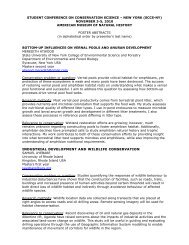Stromatolites in Western Australia, today. Did ancient<strong>Earth</strong> look like this?billion years ago. So, <strong>the</strong> origin <strong>of</strong> life isprobably <strong>the</strong> origin <strong>of</strong> evolution. <strong>Life</strong> isresourceful <strong>and</strong> entrepreneurial. It takesadvantage <strong>and</strong> it changes <strong>the</strong> chemistry <strong>of</strong> itssurroundings. <strong>Life</strong> is a fantastically complexsystem, <strong>the</strong> emergence <strong>of</strong> which remains <strong>the</strong>greatest mystery in science.Long-term changes in <strong>the</strong> composition <strong>of</strong> <strong>the</strong>atmosphere <strong>and</strong> oceans are intimately linked toboth <strong>the</strong> geophysical changes in <strong>the</strong> solid <strong>Earth</strong>itself <strong>and</strong> with <strong>the</strong> ongoing evolution <strong>of</strong> life. Theatmosphere <strong>and</strong> oceans first appeared about4.5 billion years ago, soon after <strong>the</strong> <strong>Earth</strong> <strong>and</strong>Moon completed <strong>the</strong>ir formational phase. Thiswas <strong>the</strong> time when gases escaping throughvolcanoes made an envelope <strong>of</strong> atmospherearound <strong>the</strong> young <strong>Earth</strong>, <strong>and</strong> a primitive crustsolidified <strong>and</strong> cooled to <strong>the</strong> point where liquidwater could condense. Water began poolinginto <strong>the</strong> first lakes, seas, <strong>and</strong> oceans. Theinteraction <strong>of</strong> water, heat, <strong>and</strong> rock set <strong>the</strong>stage for <strong>the</strong> origin <strong>of</strong> life.From <strong>the</strong> beginning, a number <strong>of</strong> factors haveaffected <strong>the</strong> makeup <strong>of</strong> <strong>the</strong> atmosphere tochange it from its initial state to what we havetoday. Several <strong>of</strong> <strong>the</strong>se factors, such as platetectonics, wea<strong>the</strong>ring (which recycle rocks,water, <strong>and</strong> gases), <strong>and</strong> chemical changesinduced by <strong>the</strong> byproducts <strong>of</strong> life itself, areinternal to <strong>the</strong> planet. However, external factorssuch as <strong>the</strong> slowly but ever-increasingluminosity <strong>of</strong> <strong>the</strong> Sun over billions <strong>of</strong> years,gradual changes in <strong>the</strong> <strong>Earth</strong>’s orbit over manytens <strong>of</strong> thous<strong>and</strong>s <strong>of</strong> years, <strong>and</strong> <strong>the</strong> rare butcatastrophic impacts <strong>of</strong> giant meteorites <strong>and</strong>comets, have also played an important role.The atmosphere <strong>of</strong> our planet did not originallycontain all <strong>the</strong> free, breathable oxygen it doesnow. The first permanent atmosphere arosewhen gases that had been dissolved in <strong>the</strong>molten planet during its assembly from smallerbodies, called “planetesimals,” were released to<strong>the</strong> surface by volcanism. That first, primitiveatmosphere was probably several times denserthan what we have now, <strong>and</strong> was dominatednot by oxygen, but by carbon dioxide—amajor greenhouse gas. O<strong>the</strong>r gases, such asmolecular nitrogen, water vapor, <strong>and</strong> smallamounts <strong>of</strong> carbon monoxide, sulfur gases, <strong>and</strong>trace quantities <strong>of</strong> methane, <strong>and</strong> hydrogen werealso present.Astrophysical computer models based on <strong>the</strong>study <strong>of</strong> young stars <strong>and</strong> <strong>of</strong> star-forming regionsin <strong>the</strong> galaxy strongly suggest that <strong>the</strong> Sun wasmuch dimmer when <strong>the</strong> first life emerged on<strong>Earth</strong>, over 4 billion years ago. A dimmer Sunwould have supplied less solar radiation towarm <strong>the</strong> early <strong>Earth</strong>. To keep <strong>the</strong> <strong>Earth</strong> fromstarting out as a frozen wastel<strong>and</strong>, with no hopefor beginning life to take hold, an atmospheric“greenhouse” must have kept <strong>the</strong> surface zonewarm enough to maintain water in liquid form.Liquid water is <strong>the</strong> prerequisite for life.Greenhouse gases in much higher abundancethan today, primarily water vapor, carbondioxide, <strong>and</strong> methane, would have formed a<strong>the</strong>rmal blanket over <strong>the</strong> surface <strong>of</strong> <strong>the</strong> early<strong>Earth</strong> that strongly absorbed outgoing <strong>the</strong>rmalradiation. This leads to a significantly enhanced,warming “greenhouse effect” that <strong>of</strong>fset <strong>the</strong>dimmer Sun. Without this very different,greenhouse gas-rich <strong>and</strong> oxygen-poor earlyatmosphere to begin with, life would havegotten a frozen start. (See <strong>the</strong> essay by CharlesF. Keller in Section Five, which discussesgreenhouse gases <strong>and</strong> global warming.)The composition <strong>of</strong> this early atmosphere, sodifferent from <strong>the</strong> one we have now, would bedeadly for most life that is not a primitivebacterium. Soon after <strong>the</strong> emergence <strong>of</strong> <strong>the</strong>first life more than 4 billion years ago, <strong>the</strong>activities <strong>of</strong> organisms began to influence <strong>the</strong>composition <strong>of</strong> <strong>the</strong> atmosphere. As <strong>Earth</strong>’sbiosphere <strong>and</strong> atmosphere co-evolved over
illions <strong>of</strong> years, <strong>the</strong> product <strong>of</strong> photosyn<strong>the</strong>sis,mainly, free oxygen, has come to dominate <strong>the</strong>chemistry <strong>of</strong> <strong>the</strong> atmosphere. Without <strong>the</strong>byproducts <strong>of</strong> crucial biological processes suchas photosyn<strong>the</strong>sis, <strong>the</strong>re would be little or n<strong>of</strong>ree oxygen for animals to brea<strong>the</strong>, nor enoughto form a protective ozone layer in <strong>the</strong> upperatmosphere. Ozone (O3) is formed by <strong>the</strong>recombination <strong>of</strong> oxygen (O2) by solar radiationin <strong>the</strong> upper atmosphere into <strong>the</strong> new moleculewith three oxygen atoms. This molecule screensharmful ultraviolet sunlight <strong>and</strong> prevents most <strong>of</strong>it from reaching <strong>the</strong> surface. Without aneffective ozone layer in <strong>the</strong> upper atmosphere,more advanced life would not have been able toemerge from <strong>the</strong> seas to colonize <strong>the</strong> l<strong>and</strong>. Wecan safely say that <strong>the</strong> vast amount <strong>of</strong> ozoneneeded to permit <strong>the</strong> colonization <strong>of</strong> l<strong>and</strong>became possible only after significant freeoxygen accumulated from photosyn<strong>the</strong>sisbeginning early in <strong>Earth</strong>’s history.Since little evidence from <strong>the</strong> <strong>Earth</strong>’s formationaltime has survived for scientists to study, it ispossible to only make a few basic conclusionsabout <strong>the</strong> nature <strong>of</strong> <strong>the</strong> first atmosphere <strong>and</strong> <strong>the</strong>conditions in which life originated. Most <strong>of</strong> whatis known about early planetary history comesfrom three sources: <strong>the</strong> sparse geologic recordremaining from more than 3.5 billion years ago,computer models <strong>of</strong> atmospheres changing withtime, <strong>and</strong> comparing <strong>Earth</strong> to its planetaryneighbors, Mars <strong>and</strong> Venus, which evolvedalong very different paths. Scientists have alsorecently started to study <strong>the</strong> sophisticatedbiochemical machinery <strong>of</strong> primitivephotosyn<strong>the</strong>tic bacteria to learn more about<strong>the</strong>ir early evolution. These primitive bacteriaare descended from <strong>the</strong> pioneeringmicroorganisms that forever changed <strong>the</strong>chemistry <strong>of</strong> <strong>the</strong> atmosphere from a primitiveunbreathable mix to oxygen-rich air.How <strong>Earth</strong>’s <strong>Atmosphere</strong> OriginatedThe elements <strong>and</strong> compounds that make up <strong>the</strong>atmosphere <strong>and</strong> oceans evaporate readily undernormal surface conditions; that’s <strong>the</strong> definition<strong>of</strong> “volatile.” Elsewhere in <strong>the</strong> universe, <strong>the</strong>sevolatiles would assume very different physicalstates. In <strong>the</strong> space between planets <strong>and</strong> stars,where it is very cold, <strong>the</strong>y would be presentmostly as solid ices; however, near starsor in regions where new stars are beingformed, where it is hot, <strong>the</strong>y would be presentas plasma.Plasma is a fourth state <strong>of</strong> matter after solid,liquid, <strong>and</strong> gas. It exists only at extremely hightemperatures when electrons are stripped <strong>of</strong>fatoms to form charged particles. Plasma is infact <strong>the</strong> most common state <strong>of</strong> matter in <strong>the</strong>universe, yet this state is useless for life; onlysolid bodies like planets can support matter in<strong>the</strong> usable solid-liquid-gas states. <strong>Life</strong> as weknow it can occur only where a volatile such aswater is stable in <strong>the</strong> liquid state, <strong>and</strong> whereenergy resources like sunlight or chemicalenergy are available for exploitation for makingor supplying food. Such special conditions forlife seem to be satisfied only on planetaryTable 1: Comparison <strong>of</strong> atmospheric compositions <strong>of</strong> Venus, Mars, <strong>Earth</strong>pressure (bars)* CO 2 (%) N 2 (%) Argon-36 (%) H 2 0 (%) 0 2 (%)Venus 92 96.5 3.5 0.00007
















